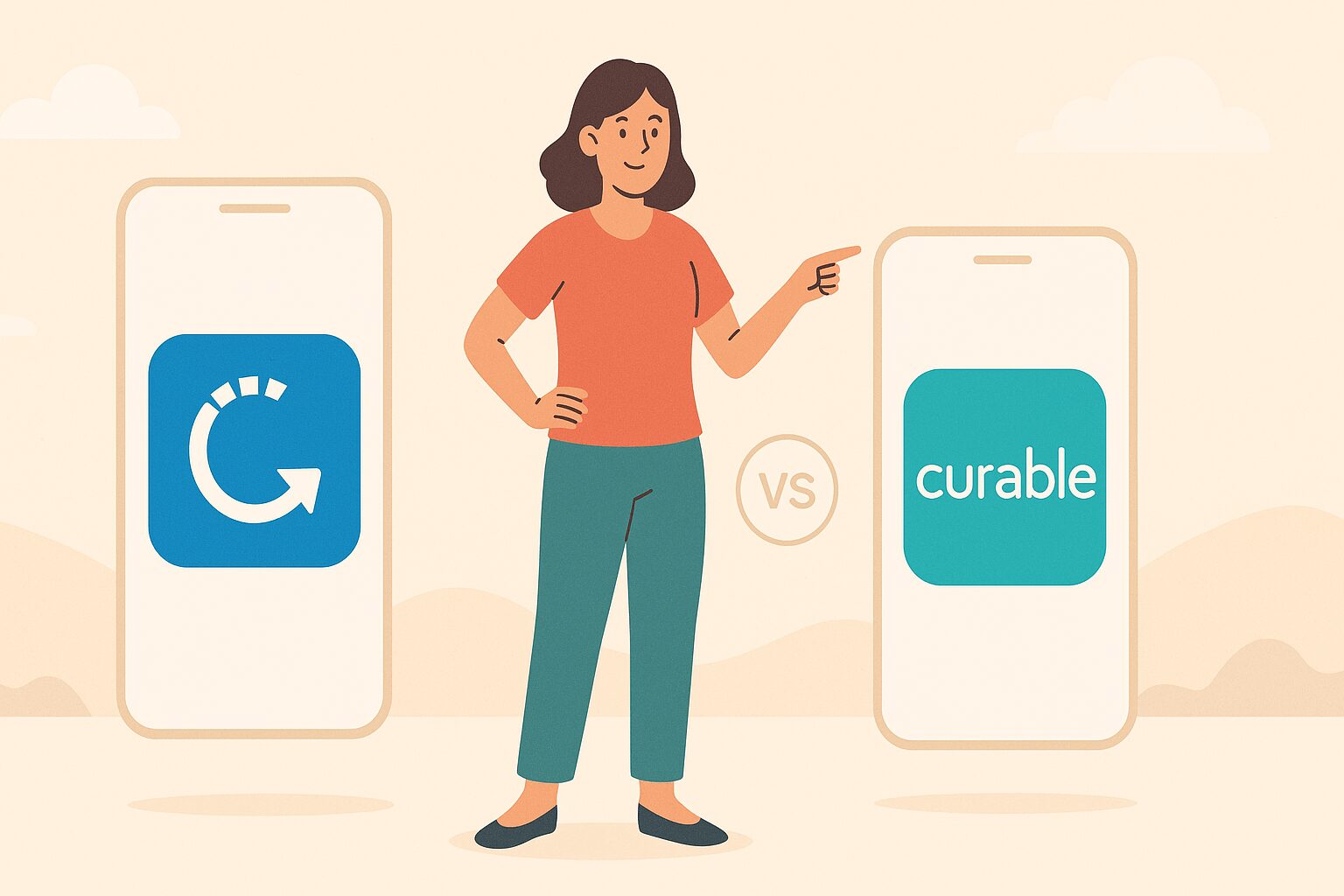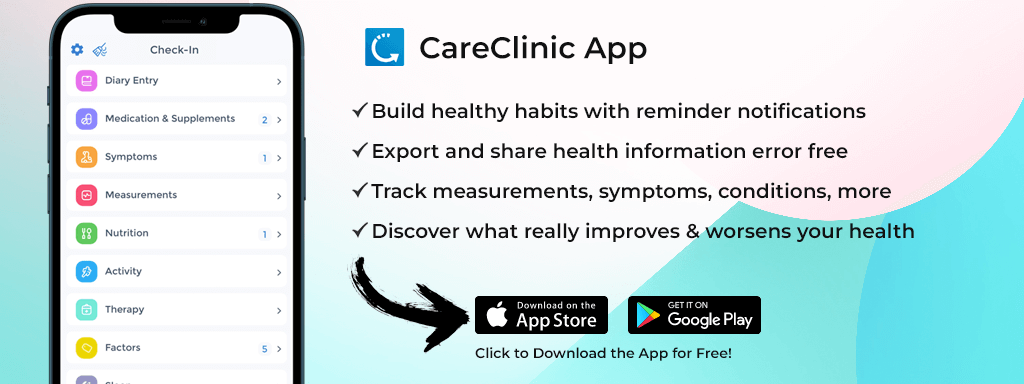
Living with chronic pain often feels like a battle fought on multiple fronts. There’s the physical reality of symptoms, the search for effective treatments, the puzzle of identifying triggers, and increasingly, the recognition of the brain’s powerful role in how we experience pain. Two digital tools, CareClinic and Curable, offer help, but they approach the challenge from fundamentally different angles. Understanding these differences is key to choosing the right support for your pain management journey.
This comparison explores what CareClinic and Curable actually do, who they’re best suited for, and how they might fit into your strategy for finding lasting relief.
Understanding the Core Purpose: Health Manager vs. Pain Therapy Program
The most crucial distinction lies in what these apps are fundamentally designed to *do*.
Curable is best understood as a structured, digital *therapeutic program*. Its primary focus is delivering education and exercises based on modern pain science, particularly concepts like Pain Reprocessing Therapy (PRT). The goal is to help users understand how the brain learns and perpetuates chronic pain and to provide tools (guided meditations, journaling exercises, visualizations, educational modules) to retrain neural pathways and reduce the fear and anxiety often associated with pain. While it likely includes basic pain level or exercise completion logging to track progress *within the program*, its core function is therapeutic intervention, not comprehensive health tracking.
CareClinic, in contrast, is a comprehensive *health management platform*. Its purpose is to empower users to track, analyze, and understand all the interconnected factors influencing their health, including chronic pain. It provides tools to meticulously document symptoms, medications, treatments, triggers (food, weather, activity, stress), lifestyle factors (sleep, nutrition), mood, and more. Its strength lies in correlating these diverse data points to reveal patterns, identify trigger relationships, monitor treatment effectiveness (including therapies like Curable), and facilitate informed communication with healthcare providers. It’s a tool for *monitoring and managing* your overall health context.
Feature Deep Dive: Addressing Different Facets of Pain Management
Let’s look at how each platform handles key aspects of living with chronic pain:
Capturing the Pain Experience
- CareClinic: Excels at detailed, multi-dimensional pain tracking. You can document intensity using various scales, pinpoint exact locations on an interactive body map (crucial for conditions like fibromyalgia or radiating back pain), describe pain qualities (burning, aching, stabbing), track fluctuations throughout the day, and note the impact on daily activities. It allows tracking of multiple symptoms alongside pain (e.g., fatigue, stiffness, brain fog).
- Curable: Offers basic pain intensity logging, primarily used to gauge the user’s progress through the therapeutic exercises. It’s not designed for detailed characterization of pain qualities, precise location mapping, or tracking complex patterns unrelated to its core exercises.
Managing Medications and Medical Treatments
- CareClinic: Features a robust system for managing pain medications (NSAIDs, opioids like Tramadol, nerve pain drugs like Gabapentin or Lyrica, muscle relaxants) and other medical treatments (physical therapy, injections, specialist appointments). It tracks complex schedules, effectiveness (how much did that Tylenol #3 *actually* reduce my pain, and for how long?), side effects, and potential interactions.
- Curable: As a therapeutic program focused on non-pharmacological mind-body techniques, it *does not include medication management features*. It complements, rather than replaces, tracking of medical treatments.
Identifying Pain Triggers
- CareClinic: Provides comprehensive tools to track and analyze potential physical and environmental triggers. This includes automatic weather data import, detailed food logging (tracking potential inflammatory ingredients or sensitivities), activity monitoring (identifying movements that provoke pain), sleep quality analysis, and stress level tracking – all correlated against your pain patterns.
- Curable: Focuses on the *brain’s interpretation* of signals and how fear/attention can amplify pain, acting like internal triggers. While it educates on these concepts, it lacks the tools to systematically track and correlate *external* physical triggers like specific foods, barometric pressure changes, or sleep disruptions with pain flares.
Addressing the Mind-Body Connection
- Curable: This is Curable’s core strength. It delivers targeted content and exercises (audio lessons, guided meditations, expressive writing prompts, visualization) based on pain neuroscience education and PRT principles to help users change their relationship with pain signals.
- CareClinic: While not a replacement for a dedicated program like Curable, it *supports* mind-body work. Its Mood Tracker, Stress log, and customizable Journal allow you to document emotional states, anxiety levels, and reflections alongside physical symptoms. CareClinic also offers its *own* therapeutic tools in the “Pathways” section, including guided meditations, breathing exercises, and soundscapes for relaxation and pain management, which can complement other therapies. Crucially, it lets you *track the impact* of Curable’s exercises on your pain and overall wellbeing.
Integrating Lifestyle Factors (Sleep, Nutrition, Activity)
- CareClinic: Features dedicated modules for detailed tracking of Sleep (duration, quality, stages, disruptions), Nutrition (macro/micronutrient analysis, correlations with symptoms), and Activity (specific exercises, intensity, impact on pain). It analyzes how these factors influence your pain levels and medication needs.
- Curable: May include journaling prompts or basic reflections related to these areas as part of its educational content, but lacks dedicated, detailed tracking modules or the analytical power to correlate these lifestyle factors comprehensively with pain patterns.
Comparing the Tools: Feature Checklist
| Feature | CareClinic | Curable |
|---|---|---|
| Detailed Pain/Symptom Tracking | ✓ | Basic |
| Medication Management | ✓ | × |
| Physical Trigger Analysis | ✓ | × |
| Pain Psychology Education/Exercises | Limited | ✓ (Core Focus) |
| Detailed Lifestyle Tracking (Sleep, Nutrition, Activity) | ✓ | Basic/Journaling |
| Healthcare Provider Reports | ✓ | Limited/Internal Progress |
| Health Record Storage | ✓ | × |
| Device Integration | ✓ | × |
| Family/Dependent Management | ✓ | × |
| Built-in Therapeutic Tools (Audio, Exercises) | ✓ (Wellness/Pain) | ✓ (Pain Psychology Focus) |
Synergy or Substitution? How These Tools Fit Together
It’s crucial to understand that CareClinic and Curable are not direct competitors; they serve different, though potentially complementary, roles.
Curable provides a specific therapeutic intervention. It teaches techniques aimed at changing the brain’s relationship with pain. It doesn’t, however, provide the tools to track the myriad of other factors influencing pain (medications, diet, weather, physical activity, sleep quality, other symptoms).
CareClinic provides the comprehensive tracking framework. It allows you to monitor *all* aspects of your health, including pain. Critically, it enables you to track the *impact* of interventions like Curable. You can use CareClinic to see if completing Curable exercises correlates with lower pain scores, reduced fear-avoidance behavior (tracked via activity logs), or improved mood over time. It provides the objective data to validate whether the mind-body approach is working for you and how it interacts with other treatments.
For someone committed to a mind-body approach for pain, using CareClinic *alongside* Curable (or a similar program) can offer the best of both worlds: targeted therapeutic exercises from Curable and comprehensive tracking and analysis from CareClinic to monitor progress, identify other contributing factors, and communicate effectively with healthcare providers about the *entire* pain management strategy.
Considering the Practicalities: Usability, Cost, and Access
CareClinic offers a modular interface that can be simplified by hiding unneeded trackers, making it adaptable despite its comprehensive nature. It operates on a freemium model, with a useful free tier and premium subscriptions unlocking advanced features. Discounts make it accessible.
Curable typically operates as a subscription service, granting access to its library of educational content and guided exercises. Its usability is centered around consuming this content and engaging with the therapeutic practices.
The value proposition differs: CareClinic offers a versatile tracking and management platform, while Curable offers access to a specific therapeutic program.
Who Benefits Most from Each Approach?
Consider CareClinic if:
- You need to track detailed pain characteristics, triggers, and patterns.
- You manage pain alongside other health conditions.
- Medication management is part of your pain strategy.
- You want to identify connections between pain and lifestyle factors (sleep, diet, activity, stress).
- You need comprehensive reports for doctors or physical therapists.
- You want to objectively track the effectiveness of *all* your treatments, including mind-body therapies.
- You use health wearables or want integrated data.
- You need features for managing family health or sharing data with caregivers.
Consider Curable if:
- Your primary goal is to learn and practice mind-body techniques (like PRT) for pain management.
- You believe psychological factors (fear, anxiety, attention) are major contributors to your pain experience.
- You are specifically seeking guided audio exercises, educational content, and journaling prompts focused on pain psychology.
- You don’t need or want detailed tracking of external triggers, medications, or other health factors.
- You are looking for a self-guided therapeutic program rather than a tracking tool.
The Bottom Line: Integrating Mind and Body Data
Managing chronic pain effectively often requires a multi-faceted approach that addresses both the physical realities of symptoms and the brain’s interpretation of pain signals. CareClinic and Curable represent tools that excel in different aspects of this process.
Curable offers a specialized therapeutic program focused on retraining the brain’s response to pain, a valuable approach for many chronic pain conditions. However, it lacks the comprehensive tracking capabilities needed to monitor the broader health context, manage medical treatments, or identify external triggers. There are also other apps that we have compared, such as Painscale, if you were considering that as an option.
CareClinic provides the robust tracking and analysis framework needed to understand the *complete picture* of your health, including pain. It allows you to monitor not just pain itself, but all the interconnected factors—medications, sleep, diet, activity, mood, stress—and critically, to track the effectiveness of *any* intervention, including mind-body programs like Curable.
For a truly integrated approach to pain management, leveraging CareClinic’s comprehensive tracking alongside the targeted therapeutic techniques offered by programs like Curable may provide the most powerful combination, giving you both the tools to change your brain’s response and the data to understand how well it’s working within your unique health landscape.


